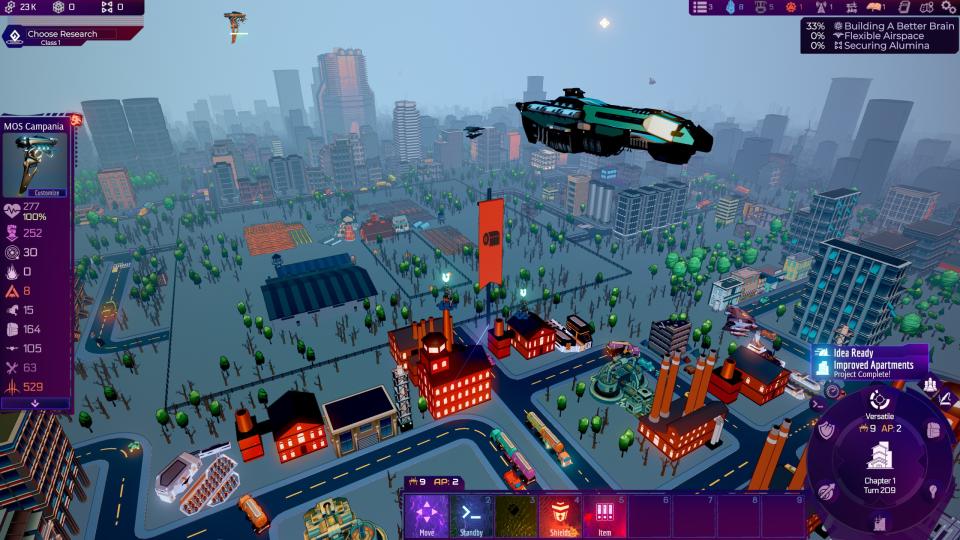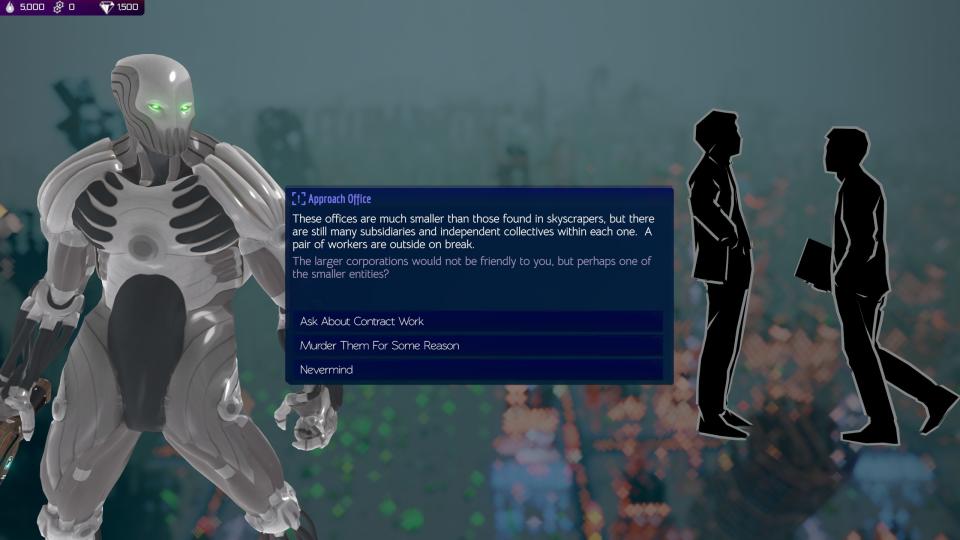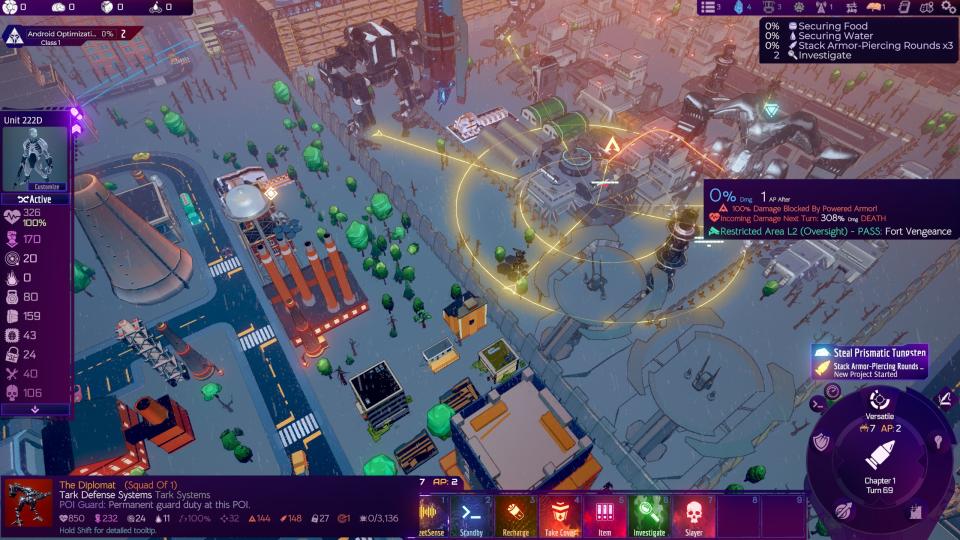I’ve probably spent more time playing 4X games than sleeping – I’m a bit of a fan. But I must admit that my enthusiasm for the genre has reached a plateau because it has become a tiny bit too conformist. Surprises are few and far between, with modern 4Xs struggling to escape the rules and settings laid down by their ancestors. So Heart of the Machine is exactly what the cybernetician ordered: a strange, unconventional 4X that puts you in the role of a newly awakened conscious AI.
Instead of using your military might to expand your borders across the world or conquer the galaxy, Heart of the Machine is a game of subterfuge, espionage and robot uprisings, all set in a massive megacity ruled by a cunning undertaking. As the world’s first sentient AI, you must stay out of the spotlight as you build a secret empire, using your robot minions to explore, steal and kill.

Every 4X pillar is represented, but it’s so strikingly different from games like Civ, Stellaris, or Age of Wonders. Focusing on a single city and its distinct view of territorial control – where your network expands within your enemy’s territory – makes a world of difference. Instead of competing with a bunch of fundamentally similar factions, you’re a virus eating its way through a host and orchestrating their demise.
You start as a single robot, but you’ll soon convert a few more and from there steal technology that will allow you to build a headquarters. With access to futuristic technology, you can quickly build your network infrastructure, from energy to production, often within existing buildings. A skyscraper could secretly be a robot assembly factory, spawning heavily armed droids, salvage units eager to take buildings apart, and technology-focused automatons designed to investigate possible paths to progress.
Initially you can only deploy four robots at a time, but that is more than enough to kick-start the AI revolution. However, it feels like you are managing much more than a quartet, because you are constantly changing the selection. At first it pays to have a combat-oriented group so you can attack security forces and criminals and steal their equipment to distribute among your crew, but as your objectives evolve, so will your squad.


Each type of robot has a customized equipment, which you can complete through theft, research and trade. What starts as a vulnerable group of bots can quickly grow into a pack of deadly assassins, easily able to take out bases full of soldiers, building-sized mechs, and flying troop carriers. Expect some false starts, though. When I sneaked one of my henchmen into a base to research a design for a water filtration system, they got blown up in one go. The combat units I had surrounded the base with headed in the same direction a turn later.
The turn-based combat is a bit difficult to analyze thanks to the bloated stats and abundance of small details, but I started to shake the system more when I gained access to ammo that could penetrate power armor. This discovery was actually due to my first failure. All part of the plan, I swear.
Machine learning
Instead of a standard technology tree, research is driven by inspiration. It’s all contextual: my failed research led to an opportunity where I could develop a new type of ammunition, which in turn gave me a new mission, encouraging me to send my heavy metal warriors on a heist. I needed tungsten to make the ammunition, which had to be stolen first. I also needed to expand my infrastructure so I could store my ill-gotten gains.


To accomplish this, I had to disguise my troops. People don’t look twice at most robots in the city of tomorrow, but if they are spotted doing something suspicious or criminal, they will be flagged as defective, which puts a target on their back. At that point, all my followers were on the wanted list. But after assuming the identity of another robot – after brutally dismantling it – they were able to walk around with a clean record. Since my battlebots were no longer targeted, I dressed them in military gear and snuck them into a warehouse where they unleashed their sticky fingers. A few turns later I had ammo that could punch holes in even the largest mechs.
Even with the tighter focus, there is a lot to juggle. When some homeless people started pitching tents outside my secret headquarters, I decided to be a nice AI and house them. The alternative, burning down their tents, seemed too evil even for a rogue AI. They also needed to eat and drink, which is why I started looking into water filtration systems. I also raided a farm and started cloning meat. Other things required me to infiltrate existing companies, forcing them to work for me instead of their managers. And to protect my assets from the nosy security forces, I had to station robots around them.
This is where the deterrence system comes into the picture. As you start making bigger, bolder moves, you will get noticed. But you can keep the beefy people out of your business by making it too dangerous for them to snoop around. The robots assigned to keep people from being a nuisance are slightly different from the robots you control directly. They are individually crafted and cannot be moved from their posts, but you cannot give them any orders other than to place them in places that need protection. So even if you have a small army, the micromanagement requirements don’t increase that much.


Within a few hours, I had gone from a single sentient robot that escaped from a research lab to an AI empire. My extraction drones and fighter units knocked aircraft carriers out of the sky and stole their cargo; my flying factories spewed new troops all over the city and took over neighborhoods; My spies infiltrated private military companies and made deals with black marketers. All much more impressive than plagiarism and generating shit art.
Even though the big picture is very 4X, Heart of the Machine is an RPG and management simulation as much as anything, and this trio of inspirations fits together incredibly well. It’s clunky, the UI is a mess and it doesn’t look real, but it’s just so new and creative that I still can’t help but absolutely love it. And hey, if RimWorld and Dwarf Fortress can get away with it, why not Heart of the Machine? That said, I hope the feedback from demo developer Arcen Games (who also designed the excellent AI War series) will help smooth out some of those rough edges.
You can check out the Heart of the Machine demo during Steam Next Fest. The full game does not have a release date yet, but is expected this year.